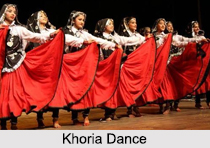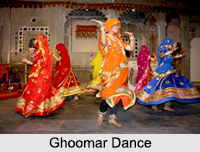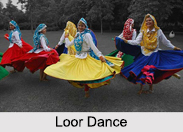 The folk dances of Haryana showcase the state"s rich folklore and tradition and reflect the cultural background of the people. These folk dances create a sense of unity and togetherness among the people, be it festivals, fairs, or ceremonies like marriage, birth or even harvest season, the people come together to dance and rejoice. Listed below are some of the major folk dances of Haryana.
The folk dances of Haryana showcase the state"s rich folklore and tradition and reflect the cultural background of the people. These folk dances create a sense of unity and togetherness among the people, be it festivals, fairs, or ceremonies like marriage, birth or even harvest season, the people come together to dance and rejoice. Listed below are some of the major folk dances of Haryana.
Phag Dance
This dance form is performed by the farmers in the month of Phalgun. Both men and women can perform this dance. During performance women wear colourful traditional clothes whereas men wear colourful turbans.
Saang Dance
Saang dance is a ritualistic popular traditional folk dance of Haryana, reflecting its culture in true sense. A group comprising of people in even numbers such as 10 or 12 people performs it. The dance mainly reflects the religious stories and folk tales that are performed in open public places and it lasts for 5 hours. Cross-dressing is quite popular in this traditional folk dance of Haryana, some of the male participants dress up as women to perform the part of the female in the dance. The meaning of `Saang` or `Swang` is disguise or `to impersonate`. It is believed that this dance form first originated and then evolved in its present form by Kishan Lal Bhaat in 1750 AD.
Chhathi Dance
In many places of India, the birth of a newborn is celebrated with pleasure. Chhathi dance is also a ritualistic dance, performed at the same occasion. But, this dance is performed only on the birth of a male child. Women perform this dance on the sixth day of the birth. It is a romantic dance and performed during night. At the end of the celebration, boiled wheat and chanaa are distributed to all the members who are present for the performance.
 Khoria Dance
Khoria Dance
The Khoria dance is a collective form of the variety of the Jhumar dance style & steps, exclusively performed by women. This dance is popular in the central region of Haryana and is connected with the daily affairs of the people and with the most important events like the harvest, agricultural work, etc. For this dance, the performers wear skirts with fine golden-thread work and brightly coloured veil-like dupatas along with heavy rustic jewellery. The simple movements acquire form and colour with the swirling of the flared skirt and these steps later increase the tempo.
Dhamal Dance
The Dhamal dance is famous in the Gurgaon area, which is inhabited by Ahirs. The origin of the dance dates back during the time of the Mahabharata. This dance is performed only by men. They sing and dance with the sound of the Dhamal beats. It is said that the people perform this dance whenever their crop is ready for harvest. In the course of action, the male participants form a semi-circle and bow down to pray for the blessings of Lord Ganesh, Goddess Bhavani and the Holy Trinity of Lord Brahma, Lord Vishnu and Lord Shiva.
Daph Dance
Daph Dance is mainly a seasonal dance performed by farmers to commemorate a bountiful harvest on the advent of spring season. The Daph or the one sided drum along with the sound of ornaments worn by the women offer the music.
 Ghoomar Dance
Ghoomar Dance
A unique traditional folk dance of Haryana, the Ghoomar dance is popular in the western parts of the state. Circular movements of the dancers mark this dance as different one. The girls from the border region of the state generally perform Ghoomar. The dancers, who take a circular mode and move about clapping and singing, perform this dance. The girls sing while they dance in a swirling movement and as the tempo of the music increases the girls form pairs and swirl faster and faster. The accompanying songs are full of satire, humour and refer to contemporary events, while the dancers twirl around in pairs. This dance is performed on occasion of festivals such as Holi, Gangaur Puja and Teej.
Jhumar Dance
The dance named after an ornament called "Jhumar", the Jhumar dance is also one of the popular folk dances of Haryana. This traditional dance is specially performed by the young girls who are married. The dance is performed to the beats of the musical instruments such as dholak and thali. The performers dress up in colourful costumes and adorn themselves with sparkling jewelleries. In some parts of the state, Jhumar dance is also popularly known as the `Hariyanvi Gidda`
.
Gugga Dance
The dance was named Gugga by the devotees of saint Gugga. This traditional folk dance of Haryana, called the Gugga dance, is performed exclusively by men. It is performed in the procession taken out in the memory of saint Gugga. In this performance, the devotees dance around the grave of Gugga Pir by singing various types of songs in his respect and praise.
 Loor Dance
Loor Dance
Girls perform the Loor dance, during the month of Phalguna also known as the spring season. This Loor dance is named after the girls in the Bangar area of Haryana. It is specially performed during the Holi festival. This dance marks the arrival of pleasant spring season and with it the sowing of the Rabi crops in the farms. The songs are generally in the form of questions and answers format. Girls usually participate in this dance wearing their traditional dress of ghagra, kurti, chundri and chunda.
Ras Leela Dance
The word Ras in Ras-Leela means dance; this traditional folk dance of Haryana was common among the people of the Braja area of the Faridabad district of the state. The dance form of Ras-Leela is filled with a variety of songs which are in praise of Lord Krishna. The songs are descriptive in nature elaborating on the various manifestations and incarnations of Lord Krishna. Ras Leela becomes a dance of spiritual ecstasy with God pervading the world as his own self and as the selves of the dancing gopis. The costumes for the dance are colourful, embroidered and have mirrors on it.
Other Folk Dances of Haryana
Other dances of Haryana include the `chaupaia`, which is a devotional dance and is performed by men and women carrying `manjiras`. In the `deepak` dance, men and women carrying earthen lamps, express their devotion through dance, which often lasts whole night. During the rains, the `Ratvai` dance is the favourite of the Mewatis. The `Been-bansuri` dance goes on with the accompaniment of `been`, which is a wind instrument and `bansuri` also known as flute.



















